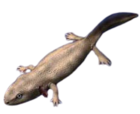| Yaksha perettii Temporal range: Early Cenomanian
| |
|---|---|

| |
| Holotype skull of Yaksha perettii, dark grey represents preserved soft tissue | |
| Scientific classification | |
| Domain: | Eukaryota |
| Kingdom: | Animalia |
| Phylum: | Chordata |
| Class: | Amphibia |
| Order: | †Allocaudata |
| Family: | †Albanerpetontidae |
| Genus: | †Yaksha Daza et al, 2020 |
| Species: | †Y. perettii
|
| Binomial name | |
| †Yaksha perettii Daza et al, 2020
| |
Yaksha perettii is an extinct species of albanerpetontid amphibian, and the only species in the genus Yaksha. It is known from three specimens found in Cenomanian aged Burmese amber from Myanmar. The remains of Yaksha perettii are the best preserved of all albanerpetontids, which usually consist of isolated fragments or crushed flat, and have provided significant insights in the morphology and lifestyle of the group.
Etymology
The generic epithet is named after the Yaksha, a class of nature and guardian spirits in Indian religions, while the specific epithet honors Dr. Adolf Peretti, who provided some of the specimens, including the holotype.[1]
Discovery
The paratype specimen was originally described in 2016 amongst a collection of fossil lizard species from Burmese amber, and was initially identified as a stem-chameleon.[2] However Professor Susan E. Evans, a researcher who has extensively worked on albanerpetontids, recognised the specimen as belonging to the group.[3] Subsequently, another specimen was discovered in the collection of gemologist Dr. Adolf Peretti, which would later become the holotype specimen.[4] The paper describing Yaksha perettii was published in November 2020 in the journal Science.[1]
Description

The species is known from three specimens, the small juvenile skeleton described in the 2016 paper (JZC Bu154), a complete adult skull and lower jaws (GRS-Ref-060829), and a partial adult postcranium (GRSRef-27746). The adult skull is 12.18 millimetres (0.480 in) from front to back, with an estimated snout to pelvis length of around 5 centimetres (2.0 in). The adult skull was found with an associated hyoid entoglossal process, a long, rod like bone situated in the oral cavity, which was embedded in remnant tongue tissue. An analogous bone exists in chameleons, which enables rapid ballistic propulsion of the tongue for feeding. The two structures evolved separately by convergent evolution.[1]

Phylogeny
Yaksha perettii was found to be in a derived position within Albanerpetontidae, similar to Shirerpeton, nested between the Early Cretaceous and Late Cretaceous-Cenozoic species of Albanerpeton.[1]
| |||||||||||||||||||||||||||||||||||||||||||||||||||||||||||||||||||||||||
References
- ^ a b c d Daza, Juan D.; Stanley, Edward L.; Bolet, Arnau; Bauer, Aaron M.; Arias, J. Salvador; Čerňanský, Andrej; Bevitt, Joseph J.; Wagner, Philipp; Evans, Susan E. (2020-11-06). "Enigmatic amphibians in mid-Cretaceous amber were chameleon-like ballistic feeders". Science. 370 (6517): 687–691. Bibcode:2020Sci...370..687D. doi:10.1126/science.abb6005. ISSN 0036-8075. PMID 33154135. S2CID 226254862.
- ^ Daza, Juan D.; Stanley, Edward L.; Wagner, Philipp; Bauer, Aaron M.; Grimaldi, David A. (March 2016). "Mid-Cretaceous amber fossils illuminate the past diversity of tropical lizards". Science Advances. 2 (3): e1501080. Bibcode:2016SciA....2E1080D. doi:10.1126/sciadv.1501080. ISSN 2375-2548. PMC 4783129. PMID 26973870.
- ^ Matsumoto, Ryoko; Evans, Susan E. (2018-01-03). Smith, Thierry (ed.). "The first record of albanerpetontid amphibians (Amphibia: Albanerpetontidae) from East Asia". PLOS ONE. 13 (1): e0189767. Bibcode:2018PLoSO..1389767M. doi:10.1371/journal.pone.0189767. ISSN 1932-6203. PMC 5752013. PMID 29298317.
- ^ "Earliest example of a rapid-fire tongue found in 'weird and wonderful' extinct amphibians". ScienceDaily. Retrieved 2020-11-17.




